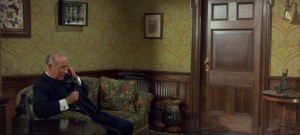I Prefer Pygmalion
August 29th, 2011
We recently watched the 1938 British film adaptation of Bernard Shaw’s 1912 play, starring Leslie Howard and Wendy Hiller. Pygmalion is my second favorite by Shaw, coming just after Caesar and Cleopatra and just ahead of The Devil’s Disciple in my humble estimation. And I owned a copy of the film on VHS as a child. I think my mother bought it to distract me from Gone with the Wind…
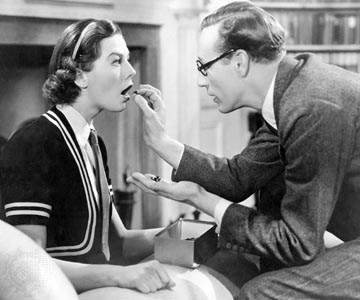
Anyway, seeing Pygmalion again kindled a desire to see My Fair Lady — or at least Hollywood’s 1964 version with Audrey Hepburn and Rex Harrison, reprising his Broadway role, originally delivered opposite Julie Andrews. I had the Broadway soundtrack on cassette, and later on LP, so have great affection for the score. Who doesn’t love Lerner & Loewe? But I must say, the film didn’t impress me in the least as I crocheted through all 170 minutes of it last weekend.
Compared to the soaring voice of Julie Andrews, Marni Nixon falls sadly flat. And the chemistry between Hepburn and Harrison is completely lacklustre. Even the edited dialogue is disappointing, after the refreshingly faithful 1938 film script. And where was that sparkling Shavian delivery that distinguishes Howard and Hiller’s exchanges? Every scene in the musical seems a beat or two behind.
By far though, the most horrifying aspect of My Fair Lady is the Edwardian decor, as imagined by 1964. That wallpaper! That upholstered sofa!
If you’re wondering how much better Pygmalion did on the same count, there’s no comparison. The film was translated seamlessly to the 1930s.
Flood on the Floss
August 28th, 2011
With hurricane Irene dominating every local media outlet, flooding is very much on our minds here in Greenwich Village. Which reminds me of my favorite (so far) literary flood, from the dramatic final volume of George Elliot’s The Mill on the Floss.
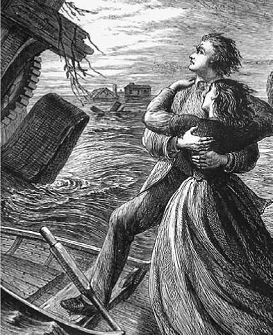
“At that moment Maggie felt a startling sensation of sudden cold about her knees and feet: it was water flowing under her. She started up: the stream was flowing under the door that led into the passage. She was not bewildered for an instant— she knew it was the flood! . . .
“And without a moment’s shudder of fear, she plunged through the water, which was rising fast to her knees, and by the glimmering light of the candle she had left on the stairs, she mounted on to the window-sill, and crept into the boat, which was left with the prow lodging and protruding through the window. Bob was not long after her, hurrying without shoes or stockings, but with the lanthorn in his hand. . .
“She was floating in smooth water now—perhaps far on the over-flooded fields. There was no sense of present danger to check the outgoing of her mind to the old home; and she strained her eyes against the curtain of gloom that she might seize the first sight of her whereabout—that she might catch some faint suggestion of the spot towards which all her anxieties tended. . .
“For the first time Maggie’s heart began to beat in an agony of dread. She sat helpless—dimly conscious that she was being floated along—more intensely conscious of the anticipated clash. But the horror was transient: it passed away before the oncoming warehouses of St Ogg’s: she had passed the mouth of the Ripple, then: now, she must use all her skill and power to manage the boat and get it if possible out of the current.”
What? You’re frustrated because I’ve left so much out — including the startling conclusion to Maggie’s boat ride? Well I guess you’ll just have to get a copy of the book and read it for yourself!
Agnes Grey
August 17th, 2011
I love to travel by train. Even though Amtrak no longer has a real club car (the kind where you can get a chocolate malted in a real glass), I still seek out the vestigial “cafe car,” squint my eyes, and pretend I can hear the chink of flatware on the railroad’s monogrammed china. The swaying movement of the train is a perfect accompaniment for my frequently racing thoughts, and I rarely feel so comfortable reading, writing, or just daydreaming as I do while on a train.
Last weekend, on my way to Wilmington, Delaware, I whiled away the two hour trip with a crocheted edge for my next petticoat and a copy of Anne Bronte’s debut novel, Agnes Grey. I finished the book on the way home, a few days later. It was a quick, pleasant read. Nothing terribly moving or deep, but sweet and charming for a purely personal reason: namely, my great-great grandmother was called Agnes Grey.
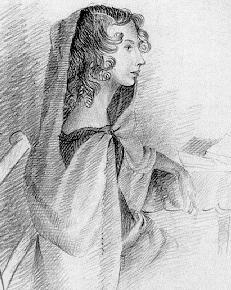
Anne Bronte, sketched by one of her sisters
Agnes Grey was first published in 1847 as the third volume to Wuthering Heights, by sister Charlotte. It was credited to Acton Bell, Anne’s masculine nom de plume. The story follows its titular character from her sheltered youth as the daughter of a clergyman who falls on hard times, through her two difficult posts as governess to bourgeois families, and to a happy, yet obvious conclusion. Like many novels of its time, Agnes Grey promises to reveal the seamy side for the general moral benefit of its readers. However the revelations are hardly shocking, and it’s hard to feel much sympathy for Agnes, who is diffident to the point of simpering.
I can only hope my own Agnes Grey (the daughter of decayed Scottish nobility whose family immigrated to Philadelphia in the 1840s) had a little more spunk.
Why I Read
July 31st, 2011
Lately, as my daily dose of literature has gone through the roof, I’ve begun asking myself why I read what I read. I’ve come up with a few standard answers — to impress people at cocktail parties, to improve my mind, to make up for the literature courses I missed. I might also say that I read the modern classics as a form of research, since I often find very telling passages to support (or disprove) my ideas about social customs of the past.
But perhaps the most compelling, or at least the most unusual, impetus for my literary selections has actually been a series of crushes on dead actors. Yes, I am here to admit in public that I first read:
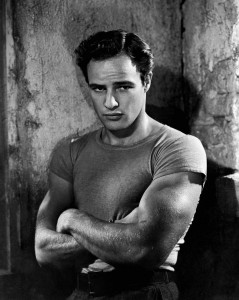
Tennessee Williams because of Marlon Brando;

Bernard Shaw because of Claude Rains and Stewart Granger (swoon);
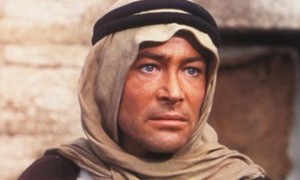
T.E. Lawrence because of Peter O’Toole;
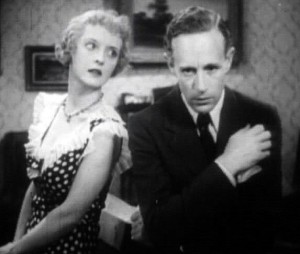
and Somerset Maugham for Leslie Howard.
Granted, this explanation doesn’t fit all of my recent reading material, but when I go on to say that each of these books then led me to other books, you will see that I actually read Confessions of an English Opium Eater in nearly direct response to What’s New Pussycat? And really, taken side by side, they are surprisingly analogous!
Hateful Heroines
July 3rd, 2011
What is it with Thomas Hardy and heroines so unsympathetic that we actually cheer their downfall? I thought Bathsheba Everdene was a pill (at least until the very end), but I must say that Eustacia Vye takes the cake. Written 4 years later, perhaps Eustacia was the product of the writer’s growing confidence in his ability to sell novels despite their being about truly horrifying people.
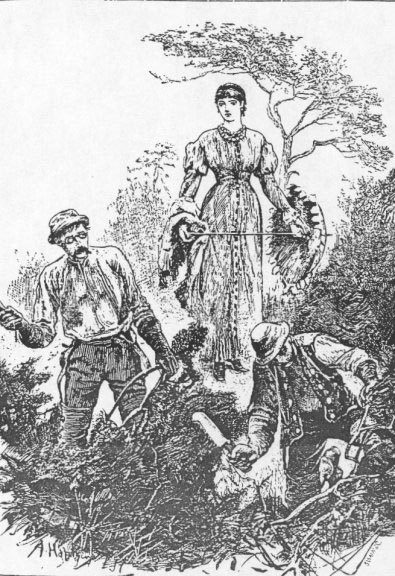
An original illustration, showing Eustacia’s cruelty.
I read Return of the Native (1878) on the plane home from California, and found myself repelled by nearly all the characters, with the possible exception of the insipidly sweet “Tamsie”, but by none so completely as Eustacia. I think it was Hardy’s gift to shine unflinching daylight on the very worst in the name of representing things as they were, rather than to hold up the dim and flickering candle by which his predecessors attempted to show us the often imaginary, nobler side of man’s nature. I have a perverse pleasure in watching the suffering of his characters, as I can’t help enjoying the feeble death throes of a roach I’ve just stepped on. I wonder if Hardy felt the same way while he was writing them? Or did he love them as fellow sinners and fellow countrymen, blaming their shortcomings on the darkening of the world as it slipped away from rural simplicity?
Although I continue to be entranced by Mr. Hardy’s quaint viewpoint, I am taking a breather before diving into The Mayor of Casterbridge or Under the Greenwood Tree, both of which are waiting patiently on my shelf (the one a paperback purchased last week, the other a 19th-century edition and gift from a dear friend).
« Newer Posts — Older Posts »
